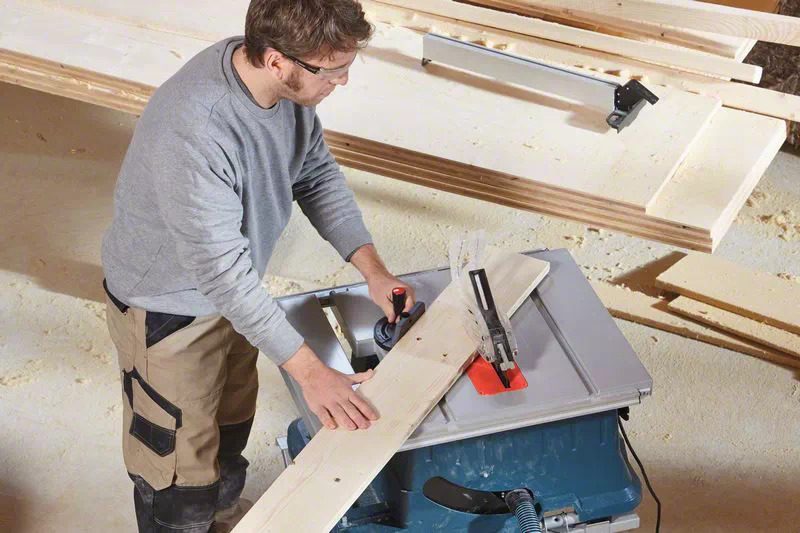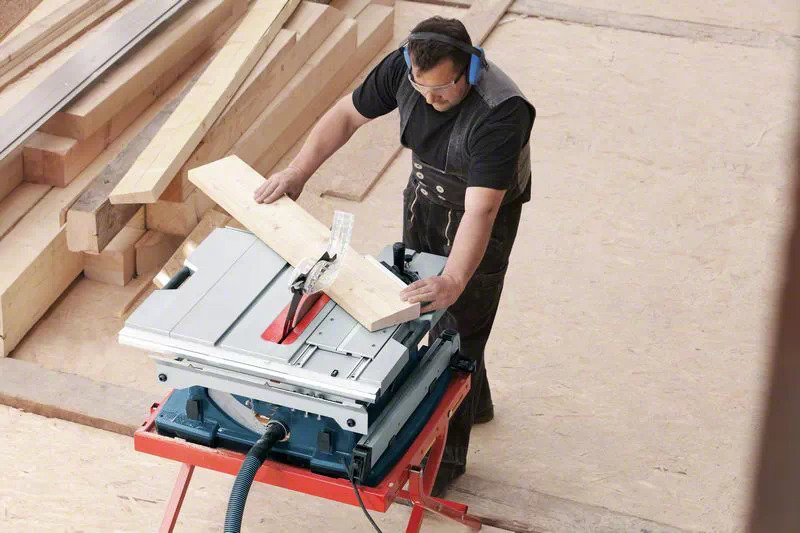What are the differences between the new Bosch GTS 635-216 and the old 10 XC table saw? Find out in this article

Last year, Bosch introduced their new entry-level table saw: the GTS 635-216. It was like their old, green PTS 10 and big, flagship GTS 10 XC had a baby. A new blue table saw, the size and price of the old PTS 10, but with the updated looks of the GTS 10 XC.
This was a welcome replacement, as the old PTS 10 had its time and had been caught out by the competition. It was just not that great a machine – I’ve seen so many defective PTS 10s being offered on second hand websites.
But how good is this new GTS 635-216? And how does it compare to the flagship model, the GTS 10 XC? I’ve done the research and will explain their differences in this article.
The most obvious difference between the two is that the 635-216 is smaller. It has a smaller body and smaller blade.
While the 10 XC supports up to 254mm (10″) blades, the 635-216 can only do maximum 216mm blades. This also explains the 216 in the name of the saw.
As a result, the 635 can cut up to 70mm high, compared to the 79mm of the GTS 10 XC. This difference is actually surprisingly small. Most 216mm saws can cut less than 70, and most 254mm table saws can cut higher than 79mm. In this case, the bigger machine doesn’t have a big advantage.
But if you tend to cut very thick stock, the 10 XC is still the better choice. If you cut mainly sheet goods, the 635 can cut plenty high enough.

Something similar is going on with the size of the two saws. The GTS 10 XC is clearly bigger, with a table of 584 x 759 millimeter, compared to the 500 x 658 millimeter of the 635-216.
However, the rip capacity is actually the same on both saws! Both the GTS 10 XC and 635-216 have a rip capacity of 635mm. This rip capacity also explains the other part of the name (635). The GTS 10 XC is significantly heavier at 35kg, compared to 22kg of the 635-216.
So, given the larger and heavier table, your workpiece will be better supported on the 10 XC. But if you really want to, you can make the same large cuts on the small 635-216 as you can on its larger brother. 635mm is large enough to cut a standard sized plywood sheet in half on the short side.

Where the GTS 10 XC does have a clear advantage, however, is in terms of power. Its 2100 Watt motor will help with cutting tough hardwoods like oak and maple. Especially when you get close to the maximum cutting height, the extra 500 Watt compared to the 635-216 (1600W) can be really helpful.
Conclusion: Although the 635-216 is smaller than the 10 XC, it comes surprisingly close in terms of rip capacity and cutting height. The 10 XC will still support your workpiece better, and provide a bit more power.
The second obvious difference is that the 635-216 lacks the unique sliding table of the 10 XC. The 635 simply has a standard miter gauge and two miter slots, left and right of the blade.
The miter gauge is made of plastic and lacks any positive stops. This means you’ll always have to remeasure your angle when you change it. It also has some play (movement side to side), so you may want to replace it with a more adjustable, accurate aftermarket one.
In contrast, the GTS 10 XC offers a unique sliding table mechanism, as well as a solid miter gauge. The gauge has an extra metal support bar and positive stops to remember specific angles. The sliding table runs over two linear guides and helps with crosscutting.
Although it looks good on paper, the implementation of the sliding table isn’t perfect. Many users report that it can move side to side a bit, which limits its accuracy. Some of those users have also found some DIY solutions to making it more accurate. Still, given the price of the 10 XC, you would expect Bosch to offer a bit more precision on the sliding table.
Conclusion: The GTS 10 XC clearly has the better miter gauge, with its extra support, positive stops, and the useful sliding table. Both saws do have some play in their gauge/slider, so you may need to use some DIY solutions to fix that.
Both saws have an aluminium fence that clamp in the front and back. This helps the fence to stay in position so it doesn’t bend when you push against it.
Both also have a special ‘gutter’ (aluminium profile) at the back where a block of the same shape can fall in when you clamp the fence. This block pulls the fence tight and ensures a parallel position to the blade.
On the 635-216, this ‘gutter’ isn’t used properly. The clamping block doesn’t fit into it and so it doesn’t automatically pull the fence in a parallel position.
This is problematic, because it means you have to re-check the position of the fence compared to the blade every time you change the fence’s location (if you want to be sure that it parallel at least).

Luckily, a user has designed a little block that you can 3D print and attach to the fence. This fixes the problem just described above, and lets the fence pull itself in a parallel position to the blade. But it would be nice if Bosch solved this problem themselves.
Conclusion: All in all, the GTS 10 XC has a better fence, especially straight out of the box. If Bosch fixes the problems with the 635-216, that fence should be good enough as well.
Which then is the better saw? The answer is simple: the GTS 10 XC. It is larger, more powerful, more stable, has a better miter gauge and sliding table, and a better fence. It also uses higher quality materials.
But it is also more than twice as expensive. This makes the GTS 635-216 very good value for money. It may not be as well built, or have as unique features at the 10 XC, it can cut almost the same height and rip the same width. With some attention, you can achieve the same results on the 635-216 as on the 10 XC, but for less than half the money.
It is a clear improvement over the old PTS 10, which was limited by its build quality. It is therefore no surprise that the GTS 635-216 is now one of the most popular table saws on the market in Europe.
If you don’t need the extra size and functionality of the GTS 10 XC, but just need a good basic table saw, the 635-216 is an excellent choice.
Tip: I’ve also compared the GTS 635-216 to two other popular entry level table saws: the Metabo TS 254 M, and DeWalt DWE7485. Read more in this article.
© Machine Atlas 2025
Great article, thank you
Thanks for this. Can anyone tell me how noisy the motor is on the cheaper saw, thanks.
Hi Dave, I don’t think there’s much of a sound difference. They’re both loud. If anything the GTS 10 XC will be even louder (111 vs 103 dB on the 635-216).